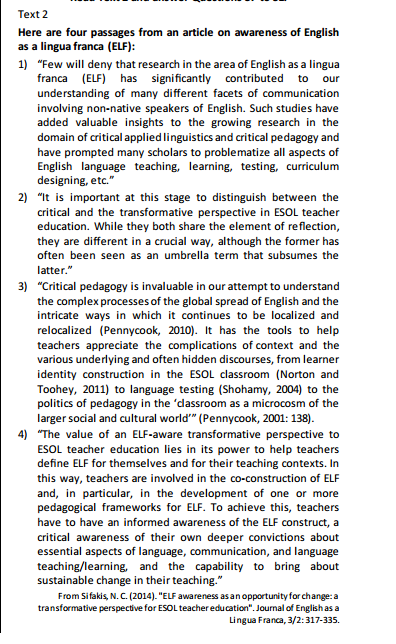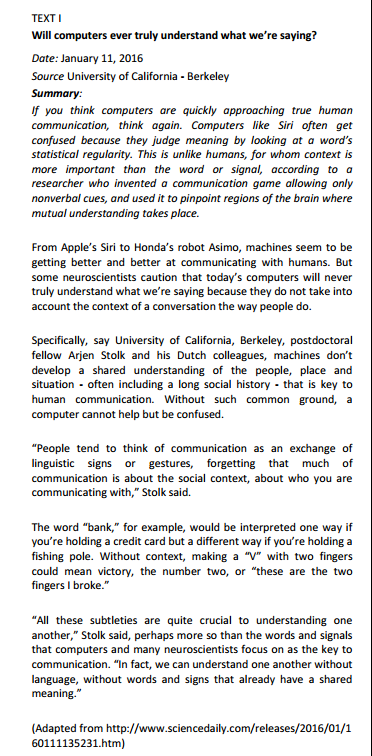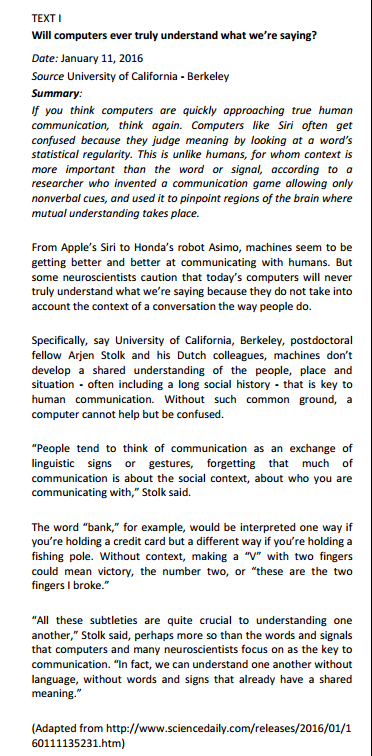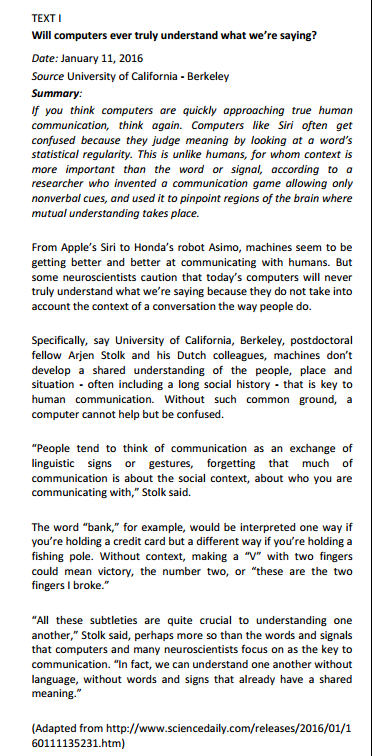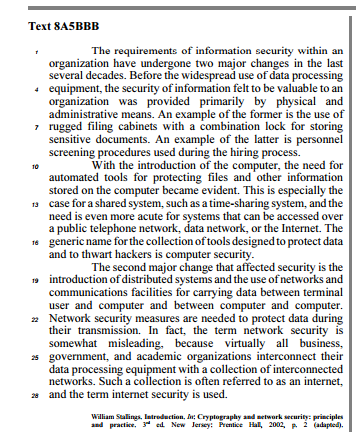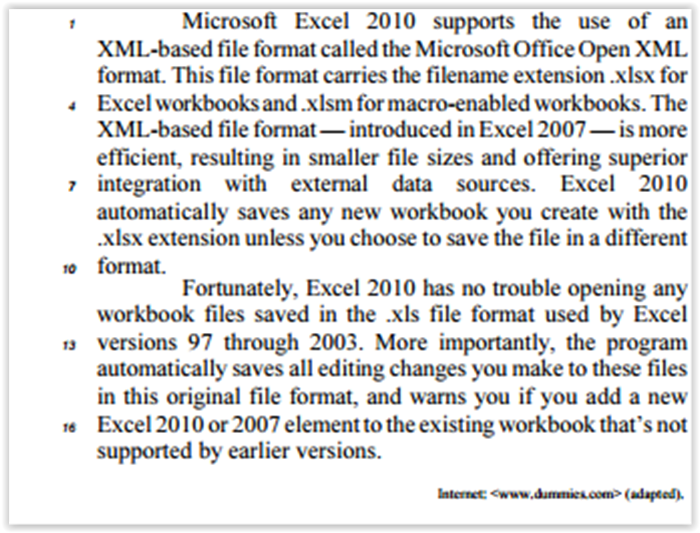The assessment tool that is in line with a critical literacy posture is
READ TEXT I AND ANSWER QUESTIONS 16 TO 20
TEXT I
Will computers ever truly understand what we're saying?
Date: January 11, 2016
Source University of California - Berkeley
Summary:
If you think computers are quickly approaching true human
communication, think again. Computers like Siri often get
confused because they judge meaning by looking at a word's
statistical regularity. This is unlike humans, for whom context is
more important than the word or signal, according to a
researcher who invented a communication game allowing only
nonverbal cues, and used it to pinpoint regions of the brain where
mutual understanding takes place.
From Apple's Siri to Honda's robot Asimo, machines seem to be
getting better and better at communicating with humans. But
some neuroscientists caution that today's computers will never
truly understand what we're saying because they do not take into
account the context of a conversation the way people do.
Specifically, say University of California, Berkeley, postdoctoral
fellow Arjen Stolk and his Dutch colleagues, machines don't
develop a shared understanding of the people, place and
situation - often including a long social history - that is key to
human communication. Without such common ground, a
computer cannot help but be confused.
“People tend to think of communication as an exchange of
linguistic signs or gestures, forgetting that much of
communication is about the social context, about who you are
communicating with," Stolk said.
The word “bank," for example, would be interpreted one way if
you're holding a credit card but a different way if you're holding a
fishing pole. Without context, making a “V" with two fingers
could mean victory, the number two, or “these are the two
fingers I broke."
“All these subtleties are quite crucial to understanding one
another," Stolk said, perhaps more so than the words and signals
that computers and many neuroscientists focus on as the key to
communication. “In fact, we can understand one another without
language, without words and signs that already have a shared
meaning."
(Adapted from http://www.sciencedaily.com/releases/2016/01/1
60111135231.htm)
Based on the summary provided for Text I, mark the statements below as TRUE (T ) or FALSE (F ). ( ) Contextual clues are still not accounted for by computers. ( ) Computers are unreliable because they focus on language patterns. ( ) A game has been invented based on the words people use. The statements are, respectively:
READ TEXT II AND ANSWER QUESTIONS 21 TO 25:
TEXT II
The backlash against big data
[…]
Big data refers to the idea that society can do things with a large
body of data that weren't possible when working with smaller
amounts. The term was originally applied a decade ago to
massive datasets from astrophysics, genomics and internet
search engines, and to machine-learning systems (for voicerecognition
and translation, for example) that work
well only when given lots of data to chew on. Now it refers to the
application of data-analysis and statistics in new areas, from
retailing to human resources. The backlash began in mid-March,
prompted by an article in Science by David Lazer and others at
Harvard and Northeastern University. It showed that a big-data
poster-child—Google Flu Trends, a 2009 project which identified
flu outbreaks from search queries alone—had overestimated the
number of cases for four years running, compared with reported
data from the Centres for Disease Control (CDC). This led to a
wider attack on the idea of big data.
The criticisms fall into three areas that are not intrinsic to big
data per se, but endemic to data analysis, and have some merit.
First, there are biases inherent to data that must not be ignored.
That is undeniably the case. Second, some proponents of big data
have claimed that theory (ie, generalisable models about how the
world works) is obsolete. In fact, subject-area knowledge remains
necessary even when dealing with large data sets. Third, the risk
of spurious correlations—associations that are statistically robust
but happen only by chance—increases with more data. Although
there are new statistical techniques to identify and banish
spurious correlations, such as running many tests against subsets
of the data, this will always be a problem.
There is some merit to the naysayers' case, in other words. But
these criticisms do not mean that big-data analysis has no merit
whatsoever. Even the Harvard researchers who decried big data
"hubris" admitted in Science that melding Google Flu Trends
analysis with CDC's data improved the overall forecast—showing
that big data can in fact be a useful tool. And research published
in PLOS Computational Biology on April 17th shows it is possible
to estimate the prevalence of the flu based on visits to Wikipedia
articles related to the illness. Behind the big data backlash is the
classic hype cycle, in which a technology's early proponents make
overly grandiose claims, people sling arrows when those
promises fall flat, but the technology eventually transforms the
world, though not necessarily in ways the pundits expected. It
happened with the web, and television, radio, motion pictures
and the telegraph before it. Now it is simply big data's turn to
face the grumblers.
(From http://www.economist.com/blogs/economist explains/201
4/04/economist-explains-10)
The three main arguments against big data raised by Text II in the second paragraph are:
According to the researchers from the University of California, Berkeley:
Based on the summary provided for Text I, mark the statements
below as TRUE (T ) or FALSE (F ).
( ) Contextual clues are still not accounted for by computers.
( ) Computers are unreliable because they focus on language
patterns.
( ) A game has been invented based on the words people use.
The statements are, respectively:
The three main arguments against big data raised by Text II in the second paragraph are:
According to the researchers from the University of California, Berkeley:

Judge the following items according to the text CB3A1AAA.
The author of the text claims that concurrent computation is an outdated issue.
The sentence “I wouldn’t marry you, unless you were the last girl on Earth” has the same meaning as:
Choose the option that presents the statement that best conveys the central idea of text 8A5BBB.
People with disabilities can use websites and web tools
when they are properly designed. However, currently many sites
and tools are developed with accessibility barriers that make it
difficult or impossible for some people to use them.
The absence of an alternative text is the classic example.
Sites and tools with images should include equivalent alternative
text in the markup/code.
If an alternative text is not provided for images, the image
information is inaccessible, for example, to people who cannot see
and have to use a screen reader that reads aloud the information on
a page, including the alternative text for the visual image.
When an equivalent alternative text is presented, in HTML
format, for example, information is available to everyone to people
who are blind, as well as to people who turned off images on their
mobile phone to lower bandwidth charges, people in a rural area
with low bandwidth who turned off images to speed download, and
others. It is also available to technologies that cannot see the image,
such as search engines.
Another example of barrier is the lack of keyboard input.
Some people cannot use a mouse, including many elderly users with
limited fine motor control. An accessible website does not rely on
the mouse; it provides all functionality via a keyboard.
Just as images are not available to people who cannot see,
audio files are not available to people who cannot hear. Providing
a text transcript makes the audio information accessible to people
who are deaf or hard of hearing.
It is easy and relatively inexpensive for website developers
to provide transcripts for podcasts and audio files. There are also
transcription services that create text transcripts in HTML format.
Most of the basics of accessibility are even easier and less
expensive than providing transcripts. However, the proper
techniques are poorly integrated into some web tools, education,
and development processes.
Internet: <https://www.w3.org> (adapted).
Judge the following items according to the text above.
Information conveyed by images may not reach the intended
public if there is no alternative text.
On the ideas of the text and the vocabulary used in it, judge the next items.
Preceding formats pose access complications for Excel 2010.
On the ideas of the text and the vocabulary used in it, judge the next items.
An important feature of Excel 2010 is its awareness of the presence of elements from different formats in the same file.
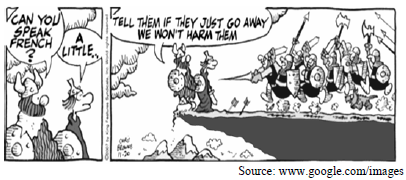 According to the cartoon, we can affirm that:
According to the cartoon, we can affirm that:

